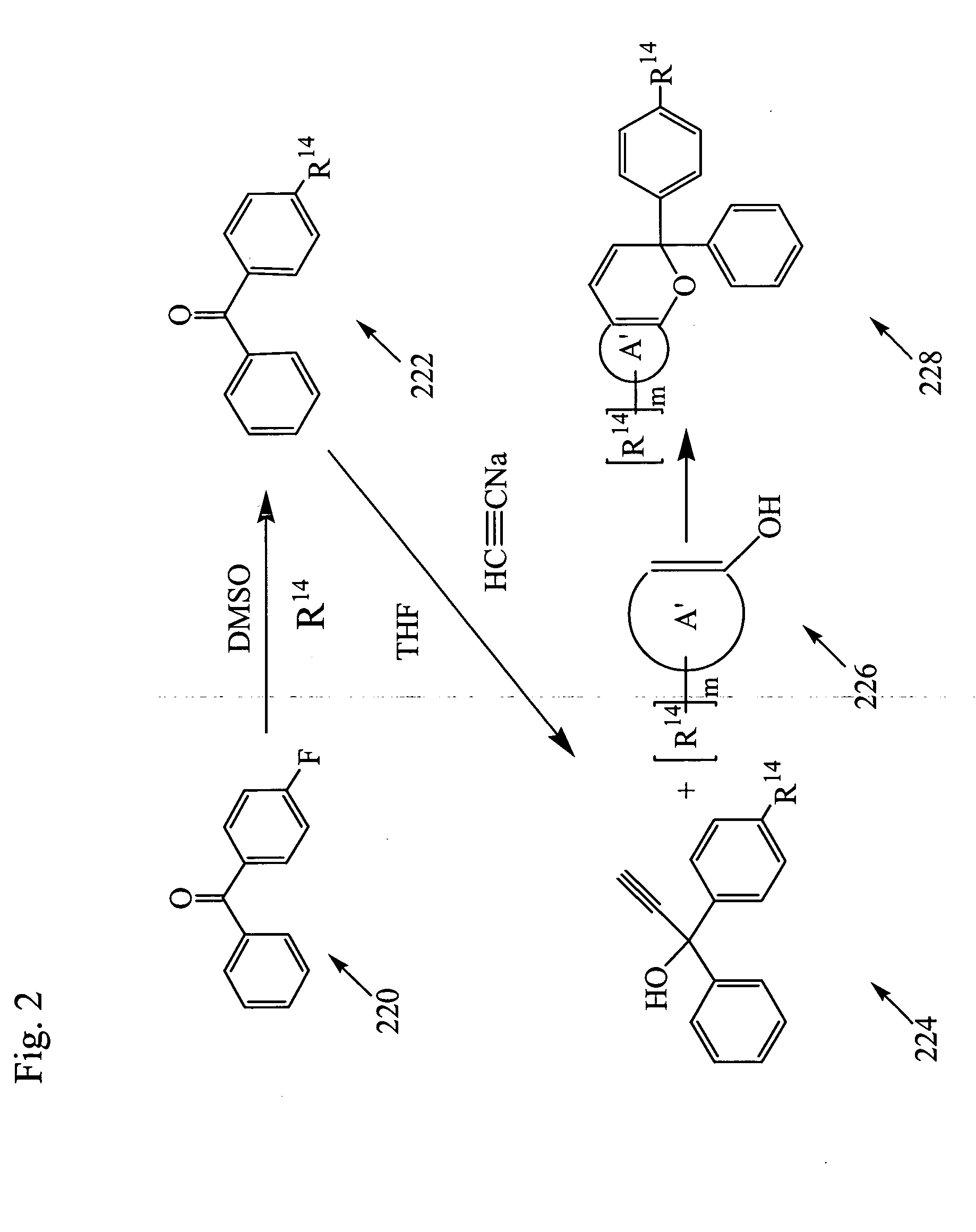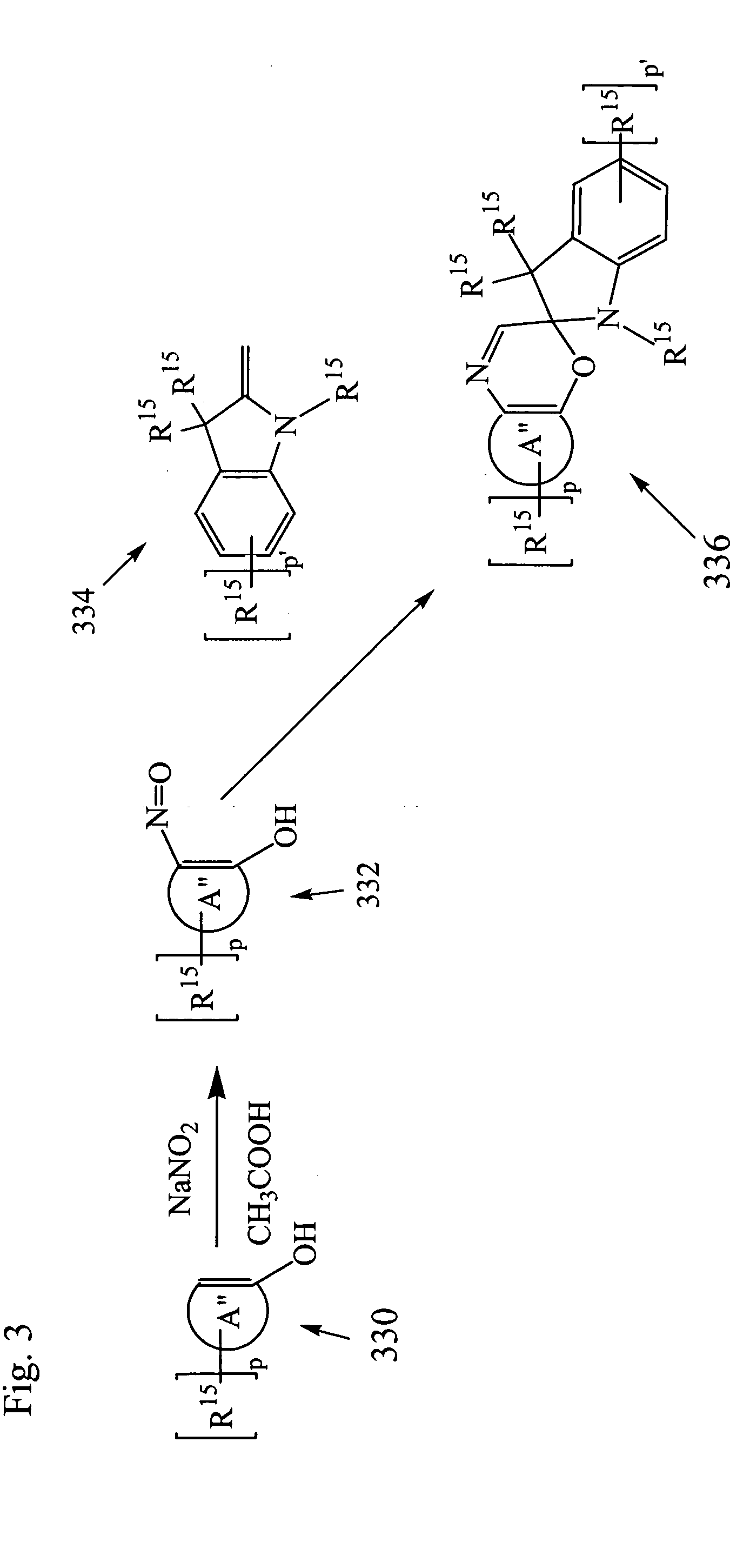Photochromic materials
- Summary
- Abstract
- Description
- Claims
- Application Information
AI Technical Summary
Problems solved by technology
Method used
Image
Examples
example 1
Preparation of Example Photochromic Material “PM-1”
[0128] Part A:
[0129] A photochromic initiator (represented by structure 1.49 in Table 1 above) was prepared as follows. To an oven-dried reaction flask was added 3-piperidinomethanol (5.1 grams) and tetrahydrofuran anhydrous (330 mL). Reaction mixture was cooled in an ice bath. To this was added 51 mL of butyllithium (2.5 M in hexanes) slowly dropwise over 20 minutes. Reaction mixture was allowed to warm to room temperature and then the desired product of Example 4, Step 6 in U.S. Pat. No. 6,296,785 (3,3-di(4-methoxyphenyl)-6,7-dimethoxy-13,13-dimethyl-3H,13H-indeno[2,1-f]naphtho[1,2-b]pyran, 11.0 grams) was charged. The reaction mixture was stirred overnight at room temperature and then slowly poured into ice water (400 mL). Aqueous hydrochloric acid (10% v / v) was added until the pH was 5 and then diluted with ethyl acetate (200 mL). The layers were phase separated and the aqueous layer was extracted with three 175 mL portions of ...
example 2
Preparation of Example Photochromic Material “PM-2”
[0132] A photochromic initiator (represented by structure 1.51 in Table 1 above) was prepared as follows. The product of Example 5 in U.S. Pat. No. 5,645,767 (which example is hereby specifically incorporated by reference) (3,3-di(4-methoxyphenyl)-6,11,13-trimethyl-13-hydroxy-3H,13H-indeno[2,1-f]naphtho[1,2-b]pyran, 200 grams) was added to a reaction flask containing 700 mL triethylene glycol and 750 mL of acetonitrile. The resulting mixture was stirred under a nitrogen atmosphere and heated to 80° C. Subsequently, 2 grams of p-toluene sulfonic acid was added to the reaction mixture. After 30 minutes at 80° C., the reaction was quenched into 8 L of water with vigorous stirring until a green solid precipitated out. The solid was filtered, washed with water, dried in air, and purified by column chromatography. Subsequent crystallization from diethyl ether yielded 152 grams of white solid. NMR analysis showed the product to have a stru...
example 3
Preparation of Example Photochromic Material “PM-3”
[0135] Example photochromic material “PM-3” was prepared using the photochromic initiator set forth in PART A of Example 2 (above) as follows: 1.5822 g of the photochromic initiator of PART A of Example 2 (above), 4.7089 g of 6-valerolactone monomer and 0.0157 g Tin(II) 2-ethyloctonate were charged under nitrogen into a three-neck flask equipped with a condenser, nitrogen inlet and a magnetic stir bar. The polymerization procedure was the same as set forth in PART B of Example 2 (above). The resultant product was a solid at room temperature, with number and weight average molecular weights of 2800 and 3500 g / mol., respectively, as determined by GPC relative to a polystyrene standard. The product is believed to consist of a mixture of photochromic materials having the structure generally represented by Formula 19 below, wherein ‘a’ is an integer ranging from 1 to 166.
PUM
| Property | Measurement | Unit |
|---|---|---|
| Volume | aaaaa | aaaaa |
| Digital information | aaaaa | aaaaa |
| Molar mass | aaaaa | aaaaa |
Abstract
Description
Claims
Application Information
 Login to View More
Login to View More - Generate Ideas
- Intellectual Property
- Life Sciences
- Materials
- Tech Scout
- Unparalleled Data Quality
- Higher Quality Content
- 60% Fewer Hallucinations
Browse by: Latest US Patents, China's latest patents, Technical Efficacy Thesaurus, Application Domain, Technology Topic, Popular Technical Reports.
© 2025 PatSnap. All rights reserved.Legal|Privacy policy|Modern Slavery Act Transparency Statement|Sitemap|About US| Contact US: help@patsnap.com



